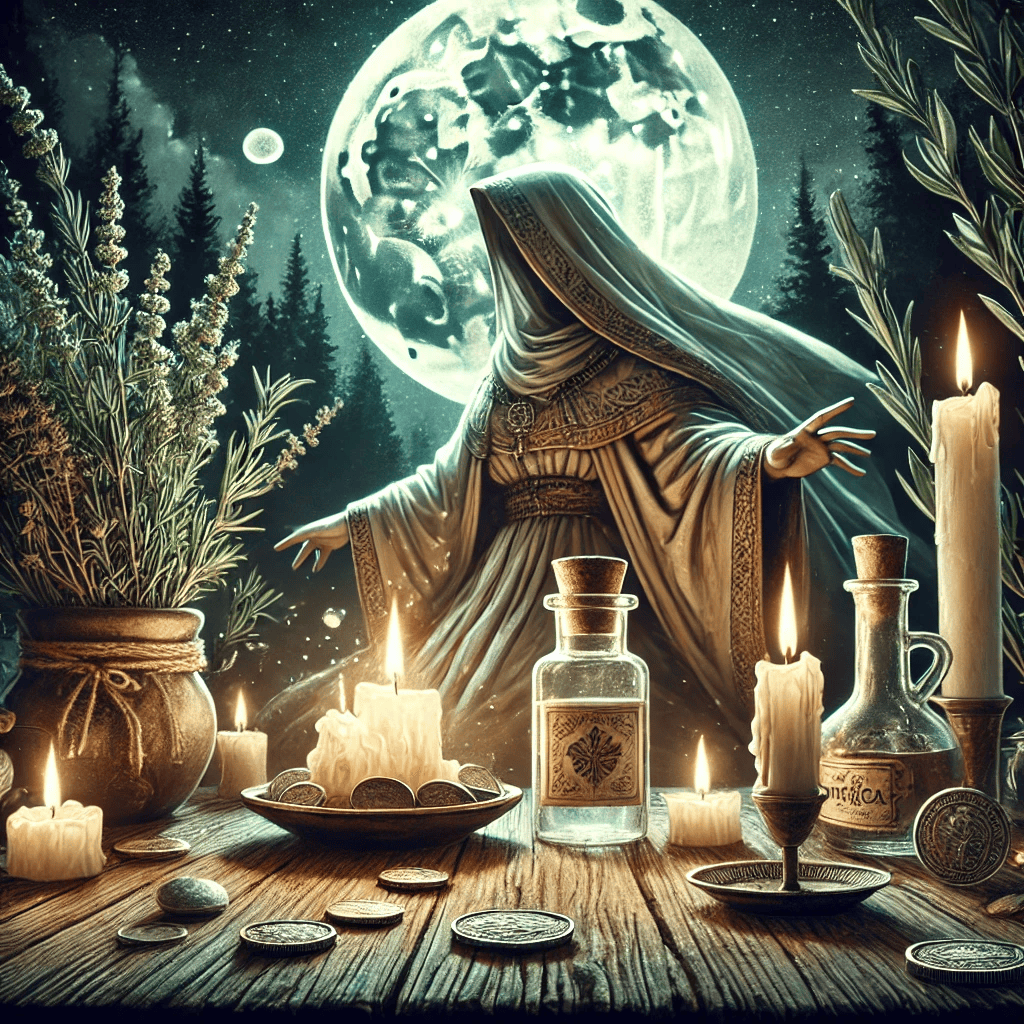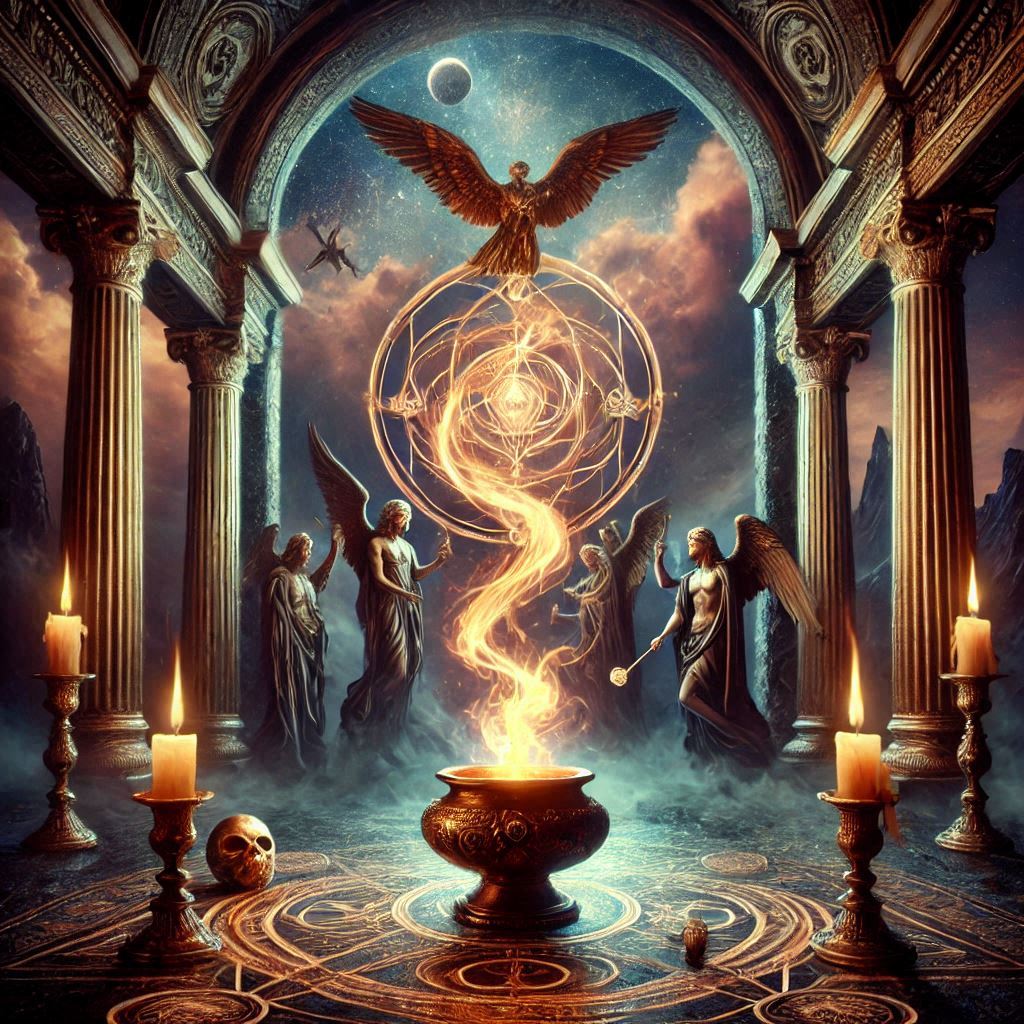Your cart is currently empty!

The Enigmatic World of Streghe and Strega A Journey Through Italian Witchcraft
Long before the word Strega was whispered in the dark, before witches became the figures of fairy tales, there was magic here—deep and enduring, woven into the earth and sky. Italy’s mystical journey began in the age of ancient gods and spirits, when the people turned to the forces of nature, and the secrets of the universe danced in the sacred groves.
The Etruscans: Masters of the Hidden Arts
The Etruscans were the ancient guardians of Italy’s first magic. Long before Rome claimed its empire, these people cast spells of divination, gazing into the animals’ hearts to divine the gods’ will, or watching the flight of birds to unravel the mysteries of fate. Their world shimmered with omens and whispers from beyond, where every rustling leaf and every flickering flame could speak with the voice of the divine.
Though the Etruscan civilization eventually gave way to Roman power, their magical traditions did not vanish; they sank deeper, merging with the spiritual beliefs that would come after them. It was as if their rituals were absorbed by the land itself, continuing to feed the roots of Italy’s mystical heritage.
Roman Enchantment: A World Alive with Spells
As the Roman Empire rose, so did the magic that infused its very core. The Romans did not simply inherit the enchantments of the past; they nurtured them, weaving magic into the daily fabric of life. They honored household gods and protective spirits—Lares and Penates—with small offerings to safeguard hearth and home, while spells and charms abounded, ensuring love’s return or a journey’s safety.
But there was also a shadowed side, a darkness that crept into Roman imagination with the figure of the Strix, the night-witch said to feast upon the essence of the living. She was feared as much as she was desired, for the Romans both dreaded and respected the power of the sorceress who could bend the will of the universe itself. Here, in the heart of Roman culture, was the seed that would later bloom into the mystery of the Strega.
The Darkening of the Light: Witch Hunts and La Vecchia Religione
With the fall of the Roman Empire and the rise of Christianity, a chill settled upon the ancient ways. What had once been sacred now became suspect, and those who held on to the old magic did so in the quiet places of the world, where the light of the new faith was dim. The land of Italy was changing, but the magic had not left; it simply wore a cloak of secrecy.
The Shadow of the Inquisition
The Middle Ages cast a long shadow over the land, and within that shadow grew fear—fear of the witch, fear of the heretic, fear of the power that lay beyond the Church’s grasp. The Inquisition rose like a dark tide, eager to root out practices that smacked of the old pagan ways. The Malleus Maleficarum fanned the flames of paranoia, painting witches as servants of darkness and spreading its terror across Europe.
Italy was not spared from the sting of persecution, though its witch hunts were not as fervent as those of its northern neighbors. Still, to be accused of witchcraft was to be accused of consorting with the forbidden. Healers, midwives, and those who knew the secrets of herbs found themselves watched with suspicious eyes. The magic did not die, but it retreated, hiding in the folds of whispered secrets and old traditions.
La Vecchia Religione (The Old Religion) Endures
Even as the fires of persecution burned, the spirit of La Vecchia Religione—”The Old Religion”—remained. It dwelled in the villages, in the hands of those who knew how to draw healing from the earth and who spoke the old words to ward off evil. The Strega of these times were not figures of malevolence; they were the keepers of the ways, blending ancient pagan practices with Christian beliefs, invoking saints alongside the old gods to preserve the magic that pulsed quietly beneath the surface.
The Strega carried this knowledge like a hidden flame, keeping the enchantments alive even as they whispered incantations beneath the light of the moon. The old magic had not died; it had become a river flowing underground, waiting for the time to rise again.
The Renaissance of the Mystical Arts
The Renaissance was a time when the veils between worlds seemed thinner, and magic found new life in the heart of Italy. It was as though the ancient spells awakened, stretching out through the art, philosophy, and alchemical pursuits that bloomed like roses after a long winter.
Hermeticism and Alchemical Wonders
The Renaissance brought with it the rediscovery of Hermeticism, the teachings attributed to Hermes Trismegistus, a figure shrouded in myth who held the secrets of the cosmos in his hands. This wisdom, veiled in the language of magic and alchemy, spoke of the connections between the earth and the heavens, and promised that those who sought true knowledge could touch the divine.
Alchemy, with its pursuit of the Philosopher’s Stone and the transformation of the spirit, found eager disciples among scholars and seekers. For these practitioners, magic was not a mere superstition but a profound art that could reveal the hidden workings of the universe itself. This rebirth of magical philosophy breathed new life into the old ways, merging ancient sorcery with the quests for enlightenment and immortality.
The Strega’s Silent Resurgence
While the nobles and scholars delved into alchemical experiments and mystical treatises, the Strega remained rooted in the earth’s magic, carrying on the folk traditions of Italy’s people. Her rituals became a blend of the old and the new, with pagan deities whispered alongside the names of Christian saints, and sacred herbs blessed under the light of the moon. She was not concerned with the lofty pursuits of court magicians; her magic was for the protection of the home, the healing of the sick, and the turning of fate itself.
Even in an age of enlightenment, the Strega walked a path of shadows and starlight, weaving her spells in quiet places and keeping alive the secrets of the ancient craft.
The Reawakening of the Old Ways: Stregoneria Today
The magic of the Strega did not fade with the passing centuries; it waited patiently, like a slumbering enchantment ready to be stirred. Today, there is a renewed reverence for the old ways, a rising tide of interest in Italy’s folk magic, and a longing for the mystical that draws people back to Stregoneria.
The Call of Aradia: The Gospel of the Witches
The revival of Italian witchcraft owes much to the mysterious text Aradia, or the Gospel of the Witches, published in 1899 by Charles Godfrey Leland. This book, claimed to be a collection of old Tuscan witch lore, tells the tale of Aradia, daughter of Diana, who descended to earth to teach the oppressed the secrets of magic and resistance. Aradia is a figure of both myth and mystery, a beacon to modern practitioners who seek a connection to the ancient powers.
Whether or not Aradia is an authentic historical document, it has become a cornerstone of the modern resurgence, inspiring a new generation to reclaim the wisdom and wonder of the old ways. It speaks to a yearning that echoes across time—a desire to touch the magic that flows through the veins of the earth.
Today’s Strega: Keepers of the Ancient Flame
Modern-day Strega practitioners, whether in Italy or far beyond its borders, carry on a tradition that is both ancient and evolving. Some adhere to the practices passed down through families, while others weave the craft into newer spiritual paths such as Wicca or Neo-Paganism. The old magic lives in rituals performed under the full moon, in charms carried for protection, and in the sacred herbs gathered from the wild. It is a tradition that speaks not only to history but to the soul’s longing for the mystical.
Unveiling the Magic: A Ritual for Protection with Diana
Now, step into the circle of the Strega and let us draw down the magic of the moon. This is a traditional rite to call upon Diana, goddess of the hunt and the moon, who is a central figure in Italian witchcraft. She is the guardian of wild places, protector of women, and a beacon in the darkness.
Gather the Elements of the Ritual
- A white candle (to invoke the purity and power of the moon)
- A bowl of water (as a mirror to reflect Diana’s light)
- A sprig of rosemary (a sacred herb of protection and purification)
- A silver coin or small object (to honor Diana’s connection to the moon)
- Optional: moonstone or clear quartz (to amplify the magic)
Casting the Circle
- Creating Sacred Space: Choose a quiet place where the whispers of the world cannot disturb you. Light the white candle and place the bowl of water before it. Let the flame dance like the light of the moon upon a dark sea.
- Purification: Wave the rosemary over the flame and around the space, chanting:
“By this flame and herb’s sweet breath, I cleanse this space and banish death. Let Diana’s light guide and protect.”
- Invocation of Diana: Take the bowl of water in your hands, gaze into its depths, and call upon the goddess:
“Diana, Mistress of the Moon, huntress who rides the night’s silver path, I call to you. Guard me with your sacred light; wrap me in your silver mantle and protect me from harm.”
- Offering and Blessing: Place the silver coin in the bowl of water. Dip the rosemary in the water and sprinkle it around you, speaking these words:
“With water’s grace and Diana’s light, I cast away all fear and blight. Blessed am I, beneath the moon’s gaze.”
- Closing the Ritual: Give thanks to Diana for her presence and extinguish the candle, saying:
“As the flame fades, my fears dissolve. I walk in your light, protected and whole.”
Keep the coin as a token of protection, and carry it with you or place it in your home. It is now a talisman blessed by Diana’s grace.
Legends and Lore: The Mystical Echoes of the Strega
Italy’s magical history is rich with legends, filled with tales of witches, saints, and sacred places where the boundaries between worlds grow thin.
- The Benandanti: In the shadowy folklore of Friuli, the Benandanti were said to be magical warriors who traveled in spirit to combat evil witches and protect the harvests. They were not mere mortals, but beings touched by enchantment, sworn to guard the fields from darkness.
- The Witches of Benevento: It is said that in Benevento, witches once gathered under a great walnut tree to dance and cast their spells. The tales of these gatherings became so famous that they were transformed into stories of the witches’ Sabbaths, dark and twisted by the fears of the Church, but they spoke of a truth—the enduring magic that stirred in the heart of Italy.
- The Saintly Witch: Some saints have magical reputations among the people. Saint Lucy is said to grant visions of the future, while Saint Apollonia has charms to soothe pain. In Italy, the sacred and the magical have often walked hand in hand.
The Magic Endures
The tale of the Strega is one of resilience, of hidden fires kept alive through the darkest times, and of a spirit that has refused to fade. Italian witchcraft is not simply history; it is a living tradition that has outlasted empires, transcended religions, and still whispers its secrets to those who seek the magic of the past.
So, when the moon is full and the air is thick with night’s enchantment, remember that the magic of the Strega is still alive. It lives in the ancient groves, in the sacred waters, in the light of the moon—and perhaps, just perhaps, it lives within you too.






